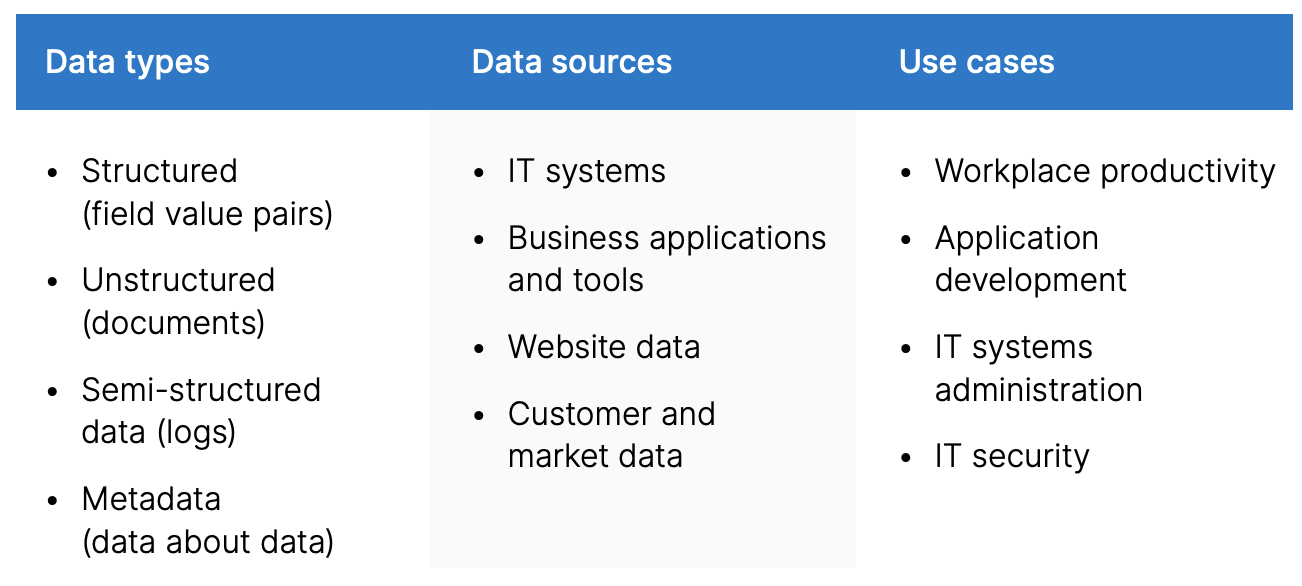How does combining search with AI solve enterprise data problems?

Is enterprise data a benefit or a burden?
Organizations are drowning in data — from security event logs and application error messages to IoT metrics and help center FAQs. This wealth of information often resides in isolated silos, presenting a substantial challenge in synthesizing it to elevate customer experiences, improve operational resilience, or mitigate security risks. Businesses increasingly find themselves stuck just storing this data or manually and slowly parsing through it. How can organizations overcome the challenges of disparate data and instead harness that data to gain actionable insights and solve problems?
The answer lies in a paradigm shift: solving the underlying data problems that are hindering your organization's ability to deliver on the business outcomes you're looking for. The intersection of generative AI and search technology epitomizes this shift. While generative AI brings formidable computational intelligence — able to generate insights and predictions from large data sets — it often lacks the context to pinpoint relevance. Conversely, search technology excels in delivering highly relevant and precise information but lacks the capability to compute or infer beyond its programmed algorithms. By bringing together these two technologies, organizations can enable their customers and employees to find answers that matter from all data — in real time and at scale.

Top 3 enterprise data challenges
Let's take a look at three major challenges shared across modern businesses:
- Serving the right information in real time: Serving the right data to the right people in the right place at the right time is challenging, but it’s important for employees and customers alike. When an organization’s users — both internal and external — spend more time searching than they should have to, it can have costly consequences for the business.
- Keeping systems up and performing: Developers, admins, and architects require tools to keep these increasingly complex digital ecosystems both available and performant. Downtime and poor performance can be costly. ITIC estimates that for most large organizations, downtime on average can cost between $500,000 to over $5 million per hour.
- Protecting and securing applications and IT infrastructure: Security analysts require tools that enable them to protect an ever-growing attack surface. A single incident can impact both customer trust and, of course, the bottom line. IBM estimates that a single data breach can, on average, cost an organization $4.45 million.

The key to navigating all of these enterprise data management challenges is to first understand that they are connected. Fundamentally, each need is addressed by getting value out of an ever-growing, ever-evolving mountain of data in real time. So how can combining search with AI help?
The power of search and generative AI combined
Search technology is the key that enables us to piece together disparate data fragments. Whether it’s facilitating a troubled customer in finding the right answer to their problem, aiding a site reliability engineer in quickly retrieving the most relevant logs, or enabling security operations centers to efficiently surface relevant security events, search technology's prowess in delivering relevant results from massive data sets is unparalleled.
By bringing together the precision of search and the intelligence of AI to enable Search AI, the scenarios above can be greatly amplified. For instance, the troubled customer can access not just a list of FAQs but a specific step-by-step answer generated based on the questions they asked. Or in the case of the site reliability engineer, rather than getting just a list of relevant logs, they can use AI to help deduce the root cause of an incident. Similarly, in the security operations center example, they can not only surface relevant security events but also use AI to help string together the entire attack sequence.
By integrating search with AI to solve data problems, organizations can transform their vast data landscapes into strategic assets, turning complex challenges into lucrative opportunities and ensuring that they not only meet but exceed expectations on all fronts.
Learn how you can operationalize generative AI to accelerate business outcomes.
Originally published July 15, 2021; updated June 17, 2024.
The release and timing of any features or functionality described in this post remain at Elastic's sole discretion. Any features or functionality not currently available may not be delivered on time or at all.
In this blog post, we may have used or referred to third party generative AI tools, which are owned and operated by their respective owners. Elastic does not have any control over the third party tools and we have no responsibility or liability for their content, operation or use, nor for any loss or damage that may arise from your use of such tools. Please exercise caution when using AI tools with personal, sensitive or confidential information. Any data you submit may be used for AI training or other purposes. There is no guarantee that information you provide will be kept secure or confidential. You should familiarize yourself with the privacy practices and terms of use of any generative AI tools prior to use.
Elastic, Elasticsearch, ESRE, Elasticsearch Relevance Engine and associated marks are trademarks, logos or registered trademarks of Elasticsearch N.V. in the United States and other countries. All other company and product names are trademarks, logos or registered trademarks of their respective owners.